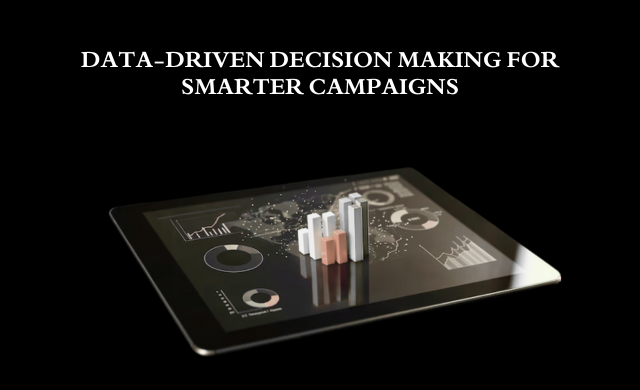Data-Driven Decision Making: Scaling Marketing with Analytics

In today’s marketing world, guessing just doesn’t cut it anymore.
The days of “throw it at the wall and see what sticks” are over. The brands that are thriving right now? They’re the ones leaning into data—hard. Because when you’re trying to scale smartly and sustainably, instinct alone won’t get you there. You need insight.
At Advait Labs, we help businesses stop drowning in data and start turning it into real, meaningful results. In this guide, we’re breaking down how to actually use analytics to grow your marketing—and your ROI—without spinning your wheels.
What Is Data-Driven Decision Making?
In general terms, data-driven decision making means you’re letting facts—not hunches—guide your marketing moves. Instead of going with your gut, you’re using actual numbers to shape strategy, tweak campaigns, and figure out what’s working (and what’s not).
So, say you’re running a few versions of an ad. Rather than guessing which one sounds best, you run the data: Which got the most clicks? Which converted the most customers? Then you double down on the winner. It’s smarter, faster, and way less risky.
Why Data Should Be at the Center of Your Marketing Strategy
Here’s what happens when you lead with numbers:
1. You target the right people, better.
With tools like web analytics, CRMs, and behavior tracking, you can pinpoint your most valuable audiences. That means fewer wasted ad dollars and more attention from people who actually want what you’re offering.
2. You move quicker—and smarter.
Got a campaign that’s flopping? Data lets you catch it early and make adjustments fast. No more waiting until the end of the quarter to realize something’s off.
3. You finally get clarity on ROI.
Using attribution models and reporting tools, you can see which channels are pulling their weight—and which ones aren’t. So when it’s time to talk about the budget, you’ve got proof in hand.
4. You create experiences that feel personal.
Behavioral data helps you customize everything from email flows to landing pages. And when your marketing feels like it’s speaking directly to someone? That’s where engagement (and loyalty) lives.
The Metrics That Actually Matter for Growth
Not all data is created equal. Here are the metrics that give you real traction when scaling:
- Customer Acquisition Cost (CAC)
- Customer Lifetime Value (CLTV)
- Return on Ad Spend (ROAS)
- Conversion Rate (CVR)
- Churn Rate
- Funnel Drop-off Rates
- Lead Quality Scores
Tracking these over time helps you catch trends, test smart hypotheses, and make strategic moves that pay off.
Must-Have Tools for Data-Driven Decision Making Marketers
You don’t need a million dashboards—just the right stack. Here are some go-to tools we recommend:
- Google Analytics 4 – For understanding user behavior
- HubSpot / Salesforce – To align marketing with sales
- Mixpanel / Amplitude – For product and feature usage tracking
- Looker / Tableau – To visualize trends and build dashboards
- Hotjar / Microsoft Clarity – For heatmaps and behavior flows
- Segment – To connect data from all your platforms
These tools make it easier to go from raw data to actionable insights without getting stuck in analysis paralysis.
Common Pitfalls Of Date Driven Decision Making
1. Drowning in data
More isn’t always better. Focus on KPIs that tie directly to business goals and leave the vanity metrics behind.
2. Attribution confusion
Last-click attribution doesn’t tell the whole story. Use multi-touch or time-decay models to get a fuller picture.
3. Siloed systems
Disconnected tools = fragmented insights. Integration is key to seeing the full customer journey.
4. Lack of expertise
Not everyone’s a data whiz—and that’s okay. That’s where partners like us come in. We help you interpret and apply your data without a headache.
Make Data Part of Your Marketing Culture
Data isn’t just for the analytics team. The real magic happens when everyone on your marketing team is thinking in terms of insights and outcomes.
- Start campaigns with data-backed goals.
- Build feedback loops based on actual performance.
- Use dashboards to fuel brainstorms—not just wrap-ups.
- Review what worked, what didn’t, and why. Every time.
When your entire team is speaking the language of data, decisions get easier, strategies get sharper, and results get way better.
Final Thoughts
Let’s face it—if you’re still relying on gut instinct alone, you’re already behind. The future (and present) of marketing belongs to teams who treat data like a superpower. Because when you understand what your audience wants, what’s working, and what to change next… you stop guessing and start growing.
At Advait Labs, we’re here to help you cut through the noise and use your data to drive results. Whether you’re refining your funnel or launching something new, the answers are already in your numbers.
Let’s uncover them together. Reach out and discover what data-driven decision making can really do for your business.
FAQs
Q: What’s the biggest benefit of marketing with data-driven decision making?
You make faster, smarter, more accurate decisions—and waste way less time and budget.
Q: Can small businesses do this too?
Absolutely. Data levels the playing field. Even simple tools can give small businesses a huge strategic edge.
Q: Do I need expensive tools to start?
Nope. Free tools like Google Analytics and entry-level CRMs can take you pretty far.
Q: How often should I check my data?
Weekly for performance, monthly for strategy. Bonus points if you’ve got real-time dashboards in the mix.
Q: Does this kill creativity?
Not at all. Data guides creativity. It shows you what resonates—so your creative work has more impact.
